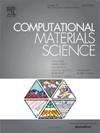First-principles simulations of liquid lead, bismuth and lead–bismuth eutectic structures: Evaluation of isobaric specific heats
IF 3.1
3区 材料科学
Q2 MATERIALS SCIENCE, MULTIDISCIPLINARY
引用次数: 0
Abstract
The simulation examines the structural properties of molten lead, bismuth, and their eutectic from melting to boiling temperatures. The MLACS method (DFT + MLIP potentials) is applied for the first time on liquid metals. It makes it possible to carry out long molecular dynamics (1500 ps), giving access to accurate calculated thermodynamics quantities. The simulation of radial pair distribution and angular distribution functions evidence a continuous evolution in temperature for the three liquids. In both cases, the self-diffusion coefficient increases with a progressive decrease of the activation energy. It evidences two different tangents at the melting and boiling points.
Finally, we can use the fluctuation method to calculate the isobaric specific heat (). begins to decrease rapidly with temperature from the melting point, in line with numerous existing measurements. Above a certain temperature, remains constant for the eutectic or increases again for pure metals.

求助全文
约1分钟内获得全文
求助全文
来源期刊

Computational Materials Science
工程技术-材料科学:综合
CiteScore
6.50
自引率
6.10%
发文量
665
审稿时长
26 days
期刊介绍:
The goal of Computational Materials Science is to report on results that provide new or unique insights into, or significantly expand our understanding of, the properties of materials or phenomena associated with their design, synthesis, processing, characterization, and utilization. To be relevant to the journal, the results should be applied or applicable to specific material systems that are discussed within the submission.
 求助内容:
求助内容: 应助结果提醒方式:
应助结果提醒方式:


